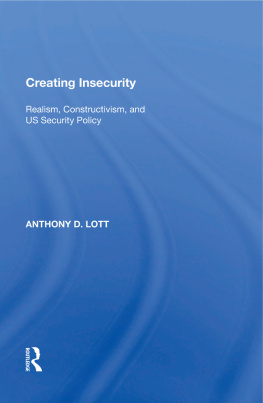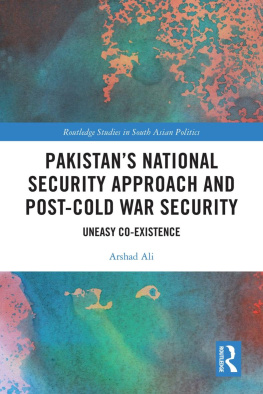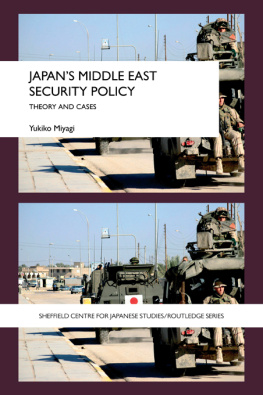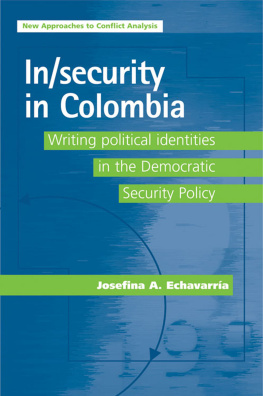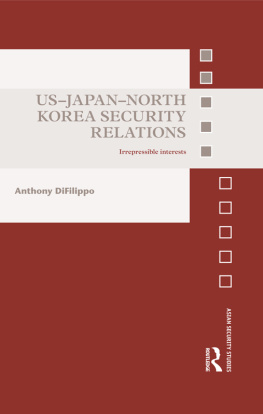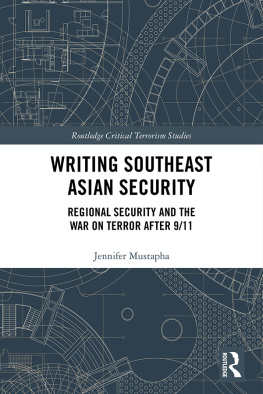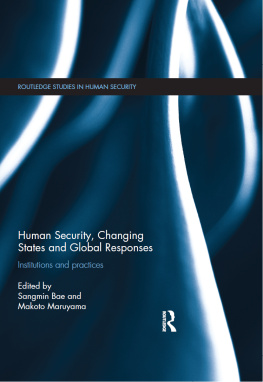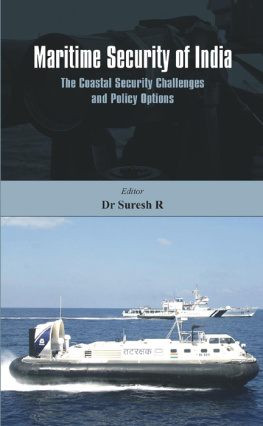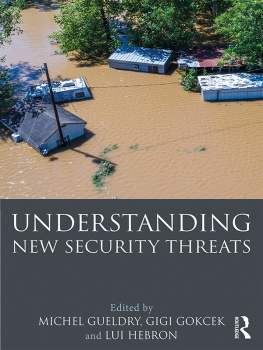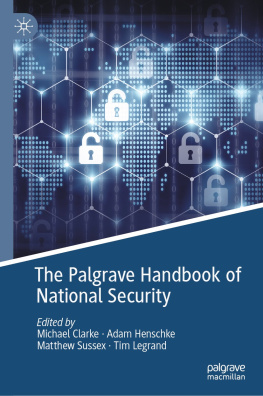Creating Insecurity
This book is dedicated to my parents.
Critical Security Series
Series Editors:
Neil Renwick and Nana Poku
Editorial Board:
Richard Bedford, University of Waikato
Tony Evans, University of Southampton
Tony Mcgrew, University of Southampton
Mark Miller, University of Delaware
Robert Morrell, University of Natal
David Newman, Ben Gurion University
Fiona Robinson, Carleton University
Peter Vale, University of Western Cape
Creating Insecurity
Realism, Constructivism, and US Security Policy
Anthony D. Lott
St. Olaf College
First published 2004 by Ashgate Publishing
Reissued 2018 by Routledge
2 Park Square, Milton Park, Abingdon, Oxon OX14 4RN
711 Third Avenue, New York, NY 10017, USA
Routledge is an imprint of the Taylor & Francis Group, an informa business
First issued in paperback 2018
Anthony D. Lott 2004
Anthony D. Lott has asserted his right under the Copyright, Designs and Patents Act, 1988, to be identified as the author of this work.
All rights reserved. No part of this book may be reprinted or reproduced or utilised in any form or by any electronic, mechanical, or other means, now known or hereafter invented, including photocopying and recording, or in any information storage or retrieval system, without permission in writing from the publishers.
A Library of Congress record exists under LC control number: 2003065199
Notice:
Product or corporate names may be trademarks or registered trademarks, and are used only for identification and explanation without intent to infringe.
Publisher's Note
The publisher has gone to great lengths to ensure the quality of this reprint but points out that some imperfections in the original copies may be apparent.
Disclaimer
The publisher has made every effort to trace copyright holders and welcomes correspondence from those they have been unable to contact.
ISBN 13: 978-0-815-38827-2 (hbk)
ISBN 13: 978-1-138-62200-5 (pbk)
ISBN 13: 978-1-351-16088-9 (ebk)
While I take complete responsibility for the opinions offered and the arguments put forth in this work, I am unable to claim it as my own. The staff at both the Watzek Library at Lewis and Clark College and the Wilson Library at the University of Minnesota provided research assistance and a quiet environment within which to work. Anne Keirby, Kirstin Howgate, Carolyn Court and Maureen Mansell-Ward at Ashgate made the editing and publishing process enjoyable. Through long discussions and feeble early drafts, friends and colleagues challenged me to develop these ideas more completely and push the boundaries of our discipline. Their thoughts are imprinted on the pages that follow. Alan Gilbert pushed me to undertake this work with a gentle hand and a reminder of the need to make this world a better place. Karen Feste provided a detailed and thorough analysis of the arguments as they emerged and challenged me to stick to the task when it seemed daunting. Jack Donnelly required me to defend the weakest of my arguments and strengthen the strongest; much work remains in this regard. Lewis Griffith undertook a thorough reading of this work near the end stage and offered valuable comments and insight. Gary Scott and Craig Carr spent time throughout the process pushing me to think critically about the ideas expressed and cajoling me to keep at it. Gary Scott, Craig Carr, Lisa Simons, Lisa Schunk, Maria Montello, and Skippy carried me through the writing process with necessary distractions beyond the halls of academia. Finally, this work would remain incomplete without the support and assistance of my family. Jennifer and Stephanie Lott coped with the eccentricities of their brother and remained supportive friends as well. My parents, Susie and Nick Lott, to whom this book is dedicated, demanded of their son just one thing: to find something in life he enjoyed that would benefit others in some way. I cannot express in words my gratitude to them for their love, support, and patience. In addition, their work editing and preparing the manuscript resulted in the pages that follow.
What is security? It has long been the dominant issue in international politics. Every successful theoretical approach to the study of the relations between states is prefaced on a commitment to understanding the concept. But while this can be stated with a high level of assurance, it is also the case that the subject of security and the sources of perceived insecurity are varied and problematic. During the Cold War, the concept was linked to the protection of the state and issues were framed as 'national security' concerns. Accordingly, security was associated with territorial integrity and the preservation of sovereignty. The physical base of the state required the vigilance of a national security apparatus dedicated to recognizing the capabilities and intentions of others. This version of security further rests on a subjective core that manages perceptions of threat and the enemy. However, the constraints of the Cold War mandated that these perceptions be left unproblematic in order to manage the policy relevant and immediate problems of securing the state.
But as the Cold War came to an end, alternative voices could be heard advocating versions of security that seem to contradict the focus and energy of the Cold War studies. Recognizing that emphasis on the state as the primary referent of security marginalized much of the human condition, more recent works focus on human security concerns. These works note the often deleterious effect that a state may have on human welfare.
See, for instance, the collection of essays in Keith Krause and Michael C. Williams, eds., Critical Security Studies (Minneapolis, MN: University of Minnesota Press, 1997); Nana Poku and David T. Graham, eds., Redefining Security: Population Movements and National Security (Westport, CT: Praeger Publishers, 1998); Richard Ullman, 'Redefining Security,' International Security 8 (Summer 1983), pp. 129-153; Jessica Tuchman Mathews, 'Redefining Security,' Foreign Affairs 68 (Spring 1982), pp. 162-177.
Bill McSweeney, Security, Identity and Interests: A Sociology of International Relations (Cambridge: Cambridge University Press, 1999), p. 33.
These two interpretations of security appear incommensurable. At the same time, neither interpretation invalidates the other. Even before the events of 11 September 2001, the physical integrity of the state remained a central concern for Recognizing the importance of both approaches to security, however, only returns us to our initial question: what is security ?
See, for example, Margaret E. Keck and Kathryn Sikkink, Activists Beyond Borders: Advocacy Networks in International Politics (Ithaca, NY: Cornell University Press, 1998); Ronnie D. Lipschutz, ed., On Security (New York: Columbia University Press, 1995).
Jutta Weldes, Mark Laffey, Hugh Gusterson, and Raymond Duvall, eds., Cultures of Insecurity: States, Communities, and the Production of Danger (Minneapolis, MN: University of Minnesota Press, 1999).
This project is intended to bring together these seemingly contradictory approaches to the study of security. However, it is not my intention to build a meta-theoretical device that can bridge the serious epistemological, ontological, and methodological differences that animate the various approaches. Rather, a more modest attempt will be made to balance a critical form of realism with the political discourses that are emerging out of constructivist writers in Security Studies. Doing so, it is hoped that various insecurities can be seen in a new way. I begin with the premise that there is something fundamentally important about national security matters. At this point in human history, the state plays a necessary role in mitigating the uncertainties of international anarchy for its citizens.insecurity that reflects both the earlier realist focus on national security and the more recent focus by constructivists on epistemological coherence and cultural influence.

